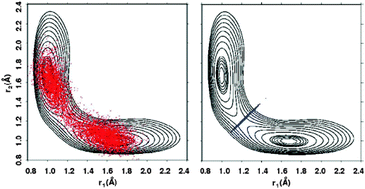Kinetic isotope effect in malonaldehyde determined from path integral Monte Carlo simulations
Abstract
The primary H/D kinetic isotope effect on the intramolecular proton transfer in malonaldehyde is determined from quantum instanton path integral Monte Carlo simulations on a fully dimensional and validated potential energy surface for temperatures between 250 and 1500 K. Our calculations, based on thermodynamic integration with respect to the mass of the transferring particle, are significantly accelerated by the direct evaluation of the kinetic isotope effect instead of computing it as a ratio of two rate constants. At room temperature, the KIE from the present simulations is 5.2 ± 0.4. The KIE is found to vary considerably as a function of temperature and the low-T behaviour is dominated by the fact that the free energy derivative in the reactant state increases more rapidly than in the transition state. Detailed analysis of the various contributions to the quantum rate constant together with estimates for rates from conventional transition state theory and from periodic orbit theory suggest that the KIE in malonaldehyde is dominated by zero point energy effects and that tunneling plays a minor role at room temperature.


 Please wait while we load your content...
Please wait while we load your content...